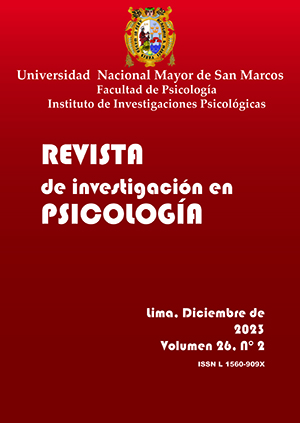Wong-Law Emotional Intelligence Scale (WLEIS-S): psychometric properties and normative data in the Peruvian adult population
DOI:
https://doi.org/10.15381/rinvp.v26i2.24376Keywords:
emotional intelligence, validity, reliability, equity, normative dataAbstract
In this study, we aimed to analyze the psychometric properties of the WLEIS-S Scale and generate normative data for measuring emotional intelligence in the Peruvian context. A total 782 people participated, 175 men (22.4 %) and 607 women (77.6 %), between 18 and 59 years old (M=29.39, DE=9.67), selected through a non-probabilistic convenience sampling. First, the metric quality of its 16 items was verified. Then, its internal structure was analyzed through confirmatory factor analysis, finding adequate fit indices for the bifactor model: χ2=305.795, CFI=.969, TLI=.958, RMSEA=.056 y SRMR=.029, in addition to evidence in favor of its unidimensionality: PUC, ωh and H coefficient >.80, ECV >.60 and explained variance of 71.97%. Likewise, evidence of its discriminant validity was found in relation to the scores of psychological discomfort measured with the K10 Scale (r=-.37, r2=.13). Also, the reliability evidence was verified by the internal consistency method for the general scale (ω=.947) and the four specific factors (SEA=.833, OEA=.798, UOE=.886, ROE=.891). Finally, evidence of equity was found according to sex and age group (ΔCFI<.010) and RMSEA (ΔRMSEA<.015). Therefore, normative data were developed for the general adult population. In conclusion, the WLEIS-S Scale is a useful instrument to measure emotional intelligence in the Peruvian context.
Downloads
Published
Issue
Section
License
Copyright (c) 2023 Miluska Glamis Moreyra-Ruiz, Lincol Orlando Olivas-Ugarte

This work is licensed under a Creative Commons Attribution 4.0 International License.
THE AUTHORS RETAIN THEIR RIGHTS:
a. The authors retain their trademark and patent rights, and also on any process or procedure described in the article.
b. The authors retain the right to share, copy, distribute, execute and publicly communicate the article published in the Journal of Research in Psychology (for example, place it in an institutional repository or publish it in a book), with acknowledgment of its initial publication in the Journal of Research in Psychology.
c. Authors retain the right to make a subsequent publication of their work, to use the article or any part of it (for example: a compilation of their work, lecture notes, thesis, or for a book), provided that they indicate the source. of publication (authors of the work, magazine, volume, number and date).






